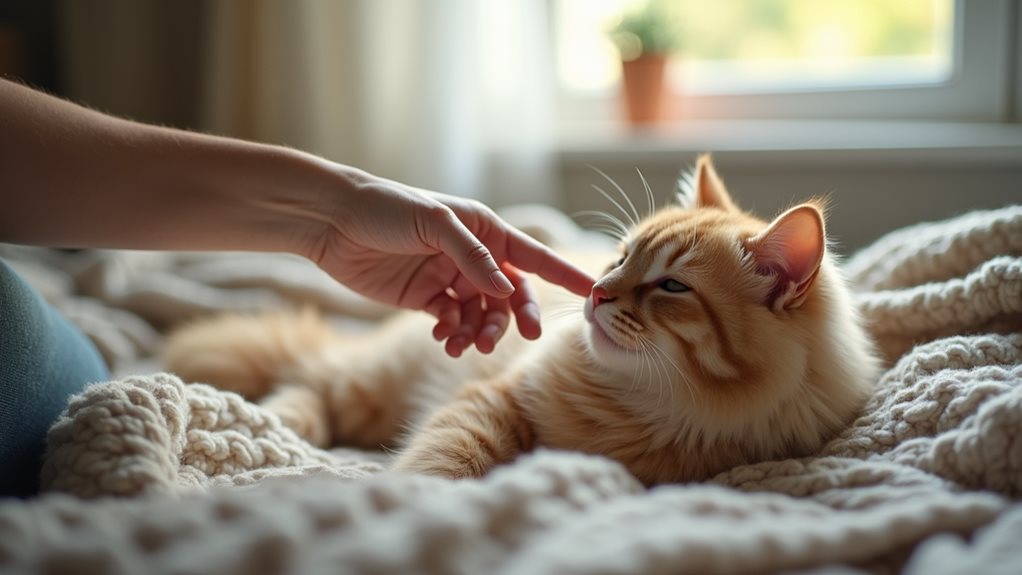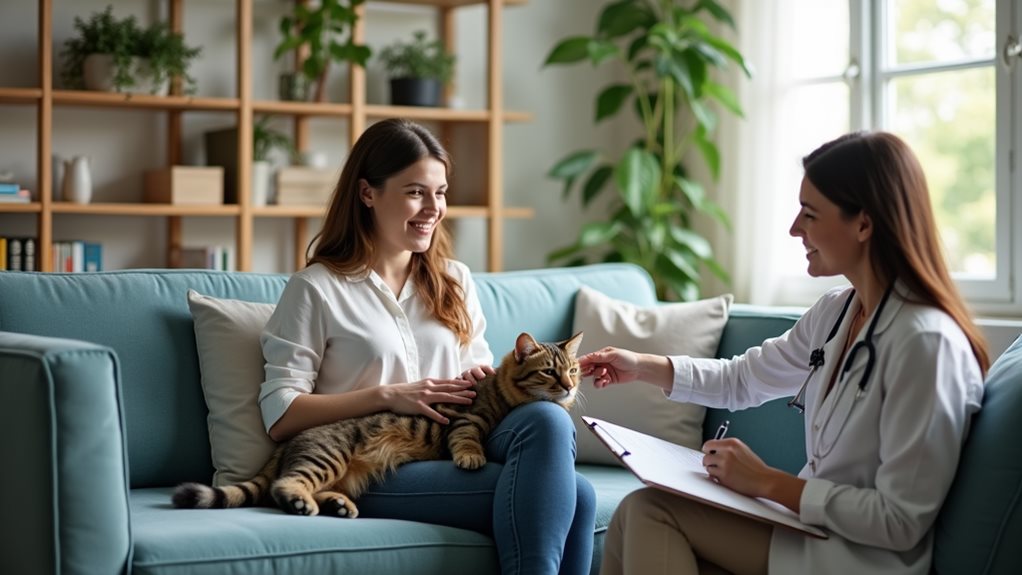
Overcoming cat phobia is achievable through a blend of understanding its roots, gradual exposure therapy, and advanced relaxation techniques such as hypnosis and Emotional Freedom Technique (EFT). These therapies gently guide one from fear to comfort by reprogramming fear responses and fostering emotional resilience. Combining these strategies offers a holistic approach to not only manage but also potentially eliminate the fear of cats, paving the way for increased confidence and peace in their presence. Further exploration reveals a deeper grasp on effective fear management.
Key Takeaways
- Explore gradual exposure therapy to slowly desensitize yourself to cats, starting with less intimidating interactions like viewing pictures.
- Consider hypnosis to reprogram your subconscious and mitigate fear responses towards cats through guided imagery and positive suggestions.
- Use Emotional Freedom Techniques (EFT) to tap on specific meridian points, reducing anxiety and changing emotional reactions to cats.
- Implement Neuro-Linguistic Programming (NLP) to alter negative thought patterns and emotional associations linked to cats.
- Combine these therapeutic approaches for a comprehensive strategy, enhancing emotional resilience and comfort around cats.
Understanding the Roots of Cat Phobia
Understanding the roots of cat phobia is vital for effective treatment and management. The origins of fear towards cats often stem from traumatic experiences such as unexpected scratches or intimidating encounters during childhood.
Additionally, cultural influences greatly shape perceptions and attitudes towards animals, including cats. In some cultures, cats are associated with superstitions or negative folklore, which can instill and perpetuate a deep-seated fear.
Recognizing these factors is essential in empathetically addressing and managing cat phobia. By identifying personal and cultural contexts, therapists can tailor interventions that respect individual experiences and cultural backgrounds, facilitating better outcomes in phobia treatment.
Step-by-Step Guide to Gradual Exposure Therapy
Having explored the origins of cat phobia, it is now appropriate to examine a practical approach for overcoming this anxiety through gradual exposure therapy.
This method involves creating a fear hierarchy, listing scenarios involving cats from least to most frightening. Exposure techniques are then applied stepwise, starting with the least anxiety-provoking situation.
Individuals gradually confront these scenarios, perhaps initially through pictures or videos of cats, progressively moving towards direct interactions.
This structured and controlled approach allows for the gradual desensitization to the fear stimuli, reducing anxiety levels effectively and empowering individuals to manage their reactions to cats in a safe, supportive environment.
Harnessing Hypnosis for Fear Reduction

While gradual exposure therapy offers a structured approach to overcoming cat phobia, hypnosis introduces a profound method for accessing and modifying the subconscious drivers of fear. Hypnosis techniques enable subconscious reprogramming, creating new neural pathways and reducing fear responses. This method not only addresses the surface level anxiety but also explores deep into the psychological roots, reshaping perceptions and reactions toward cats.
| Technique | Goal | Outcome |
|---|---|---|
| Guided Imagery | Access subconscious | Modify fear reactions |
| Suggestion | Instill positive beliefs | Increase confidence |
| Relaxation | Reduce anxiety | Enhance calmness |
| Repetition | Reinforce new pathways | Sustain changes |
| Visualization | See self without fear | Empower self-image |
This approach promises a more resilient and less fearful existence concerning cats.
Utilizing EFT for Emotional Relief and Confidence
Emotional Freedom Techniques (EFT) offer a powerful tool for those grappling with a fear of cats, providing both emotional relief and a boost in confidence.
Through EFT tapping, individuals target specific meridian points on the body, facilitating emotional release and fear management. This method integrates well into therapeutic practices, enhancing the overall approach to overcoming phobias.
Key Benefits of EFT include:
- Psychological Exposure: Directly confronts fear triggers.
- Acupressure Stimulation: Reduces anxiety by tapping on energy meridians.
- Affirmative Reinforcement: Builds confidence through positive affirmations.
- Repetition: Encourages neural pathway reformation, easing fear responses.
NLP Techniques to Change Your Perception of Cats

Neuro-Linguistic Programming (NLP) offers transformative strategies for individuals struggling with a fear of cats, by altering their perceptions and emotional responses.
By utilizing techniques such as reframing and anchoring, NLP helps reshape cat perceptions from negative to neutral or positive.
Reframing involves changing the mental representation of cats, viewing them as harmless rather than threatening.
Anchoring allows individuals to create new emotional anchors by associating feelings of calm and safety with the thought of cats.
These practices empower individuals to dismantle old fears and build new, healthier associations, leading to significant improvements in their interactions with cats.
Combining Approaches for Effective Fear Management
To effectively conquer a fear of cats, integrating multiple therapeutic approaches such as hypnosis, EFT (Emotional Freedom Techniques), and NLP (Neuro-Linguistic Programming) can be particularly beneficial.
This holistic strategy enhances emotional resilience and provides a robust defense against fear triggers. Here are specific benefits:
- Hypnosis: Accesses subconscious to reframe fear perceptions.
- EFT: Utilizes tapping to lower anxiety and emotional response to cats.
- NLP: Changes negative thought patterns and emotional associations with cats.
- Combination: Integrates these therapies to address various aspects of fear, promoting faster recovery and sustaining long-term comfort around cats.
Creating Your Personalized Plan With Professional Guidance

Crafting a personalized plan to overcome your fear of cats involves the careful guidance of a skilled therapist, who can tailor the combination of hypnosis, EFT, and NLP techniques to your specific needs.
This involves a process of expert consultation to identify underlying triggers and appropriate coping mechanisms. The therapist designs personalized strategies that are sensitive to your emotional and psychological makeup.
This bespoke approach not only facilitates a deeper understanding of your phobia but also equips you with the tools to manage and eventually conquer your fear.
The goal is transforming anxiety into confidence through structured, supportive therapy sessions.
Frequently Asked Questions
Can Children Also Benefit From These Phobia Management Techniques?
Children can benefit from tailored phobia management techniques, including exposure therapy and cognitive-behavioral strategies. These child-specific techniques address fear systematically, promoting gradual desensitization and emotional resilience in a supportive, understanding environment.
Are There Any Side Effects to Using NLP or EFT for Phobia Treatment?
Steering the waters of NLP techniques and EFT effectiveness, one may encounter mild side effects like discomfort or emotional upset. Generally, these methods are safe, fostering significant phobia relief through scientific and empathetic approaches.
How Quickly Can I See Results From Hypnosis for Cat Phobia?
Results from hypnosis for cat phobia vary; individuals may notice improvements within a few sessions. Hypnosis effectiveness in fear reduction depends on the person's responsiveness to treatment and the severity of the underlying phobia.
Is It Necessary to Own a Cat to Successfully Overcome the Fear?
Owning a cat is not necessary to overcome fear; gradual exposure therapy can effectively desensitize individuals without direct cat ownership, utilizing controlled environments to progressively introduce interactions with cats in a supportive, therapeutic setting.
Can These Therapies Help With Other Animal Phobias as Well?
Like keys opening doors, these therapies can indeed be applied to other animal phobias. Techniques such as phobia exposure therapy and animal desensitization methods are versatile, offering promise for diverse animal-related fears.
Conclusion
In summary, steering the journey to overcome ailurophobia is akin to carefully disentangling a tightly knotted rope; it requires patience, precision, and a tailored approach. By integrating techniques such as gradual exposure therapy, hypnosis, EFT, and NLP, individuals can methodically unravel the threads of their fear. With professional guidance, each person can craft a personalized plan, transforming overwhelming dread into manageable strands, and ultimately, fostering a new, peaceful coexistence with cats.



